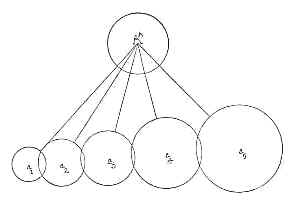
Boris Sidis Archives Menu Table of Contents Next Chapter
|
THE FOUNDATIONS OF NORMAL AND ABNORMAL PSYCHOLOGY Boris Sidis, Ph.D., M.D. © 1914 |
PART II
CHAPTER XXII
THE SYNTHETIC RECOGNITIVE MOMENT
The recognitive moment in its reproductions may be arranged in a series. The first link in the series is the sensory elements or compound. Let this be expressed by A where A is the sensory experience, and let a be the representation of the first reproduction, the next reproduction may be represented by at and the succeeding series by a2, a3, a4, a5, a6, . . . . . Each one of the series refers directly to state A with its external object. Each of them recognizes in the reproduced representation the represented, formerly perceived object of the primary state A. Each link in the series makes easier the occurrence of the succeeding one. The series forms a progression in which the link further removed from the beginning differs to a certain degree from the ones that preceded it. This progressive difference is due to the continuous progressive modifications effected in each successive link by the occurrence or reproduction of the preceding links. The process is one and continuous, and with the progress of the series of reproductions each following link becomes modified, emerges with greater ease, while the recognition is effected without any difficulty. Each previous recognition makes the next one easier.
In the character of its modification the lower form of the recognitive moment does not differ from the moment of the synthetic type of consciousness. Like the synthetic moment, the modifications are not effected consciously in the moment. The modifications are cumulative, without there being direct awareness of them. As to awareness of the previous reproduction and recognition each moment may be considered as isolated and separated. The history of the recurrences, of the reproduction and recognition is not given in the consciousness of the recognitive moment. As in the synthetic moment, an external observer is required who should read off the history of the recognitive moment from the final forms taken by psycho-physiological and sensori-motor reactions.
Expressed in a formula it may be said that each representation, each reproduction of the recognitive moment, refers to the object A of the sensory state A which may be represented as AA. Symbolically represented the relations of the successive reproduced representations to the object as presented in state A and to each other in order of their succession may be expressed by the following diagram:

In other words the representative states in the series of reproduction all refer to the original experience AA and each preceding state modifies the succeeding one, but the succeeding state does not include consciously the previous reproduction and recognition. The partial intersecting of the circles indicates that the successive states do not include their predecessors, but are only influenced and modified by them. The state, however, gets enlarged the further situated it is in the progression of the series. Each state inherits only the modifications accumulated by the preceding ones, but it does not inherit the cognition or recognition of the state itself.
In this respect the series of states going to make up the recognitive moment differs from that of synthetic type. The synthetic moment reproduces by reinstatement with modifications accumulated in the course of the process of reproductions. The recognitive moment on the contrary does not reproduce by reinstatement of presentation, but by representation. The preceding state need not be actually repeated, and if such a reference is present it is represented.
Representation is affected by different psychic elements. The same or like elements need not be reproduced in the moment of the recognitive type. In the recognitive moment of the stage considered by us such a reinstatement is altogether absent. The states following each other are different. Moreover they are isolated, disconnected in the series. The links in the series refer to the same object as presented, but they do not refer to each other in the order of their progression, state a2 does not refer to the state a1 that preceded it, nor does a3 refer to a2, nor a4 to a3, and so on. The series of states of the recognitive moment in the stage under consideration do, however, effect modifications in the order of their succession, a1 modifies a2, a2 modifies a3, a3 modifies a4, and so on each preceding state modifying the succeeding one.
The dog on seeing a person for the second or third time may recognize the friend of his master, but he does not remember that he has recognized him already on previous occasions. Similarly when the baby sees a strange person for the first'time, it may become scared and begin to cry. Subsequent repetition of similar experiences may reduce or on the contrary may increase the fear element, but the baby learns to know and recognize his man and the psycho-physiological and psycho-motor reactions follow as soon as the "man" is caught sight of. Reproduction and recognition become easier, but it is questionable whether the baby like the intelligent dog, in recognizing the person, is aware of having recognized the person on previous occasions. The dog and the child are aware of the person and recognize him, but they are not aware of the series of preceding recognitions. A form of moment-consciousness with a series of isolated reproductions and recognitions, but with accumulated modifications may be termed the synthetic accumulative recognitive moment.